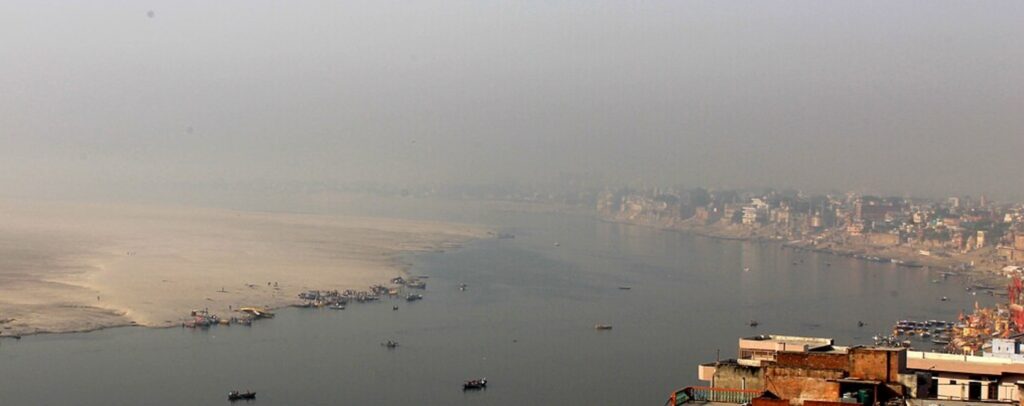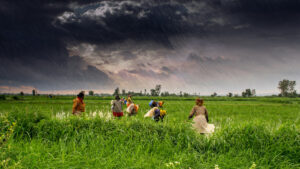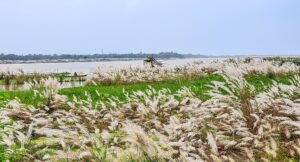Human Activity Is Causing The Ganga To Dry At Levels Never Seen Before
Oct 21, 2025 | Pratirodh Bureau
Aerial view of the Ganga river from Varanasi (Image by La Fessée via Wikimedia Commons)
- The Ganga river is experiencing its most severe drought ever recorded, with the steepest decline in streamflow in over 1,300 years.
- Reduced monsoon precipitation, global warming, and groundwater depletion from irrigation are the primary drivers of this unusual drying.
- Most climate models fail to capture the ongoing decline accurately, highlighting the need for better projections and adaptive water management strategies.
Data sets capturing records of prehistoric trees, sediments, and other geologic materials have revealed new facts about the changes currently occurring in the Ganga river basin. A team of scientists and researchers at the Indian Institute of Technology, Gandhinagar, traced the Ganga river’s streamflow levels across a millennium, finding that the Ganga is not only in the midst of a prolonged period of drought, but that it’s the most severe drought ever recorded for the river.
The Ganga river flows through five states in India, and its basin extends into Nepal, Bangladesh, and China, sustaining a population of at least 600 million. The researchers contend that the current unprecedented drought over the river basin is due to a combination of factors, including the impacts of global warming and the immense pressures on the river exerted by the population dwelling along its banks.
That the Ganga river’s streamflow has declined in recent times isn’t itself new information – several studies have made findings to the same effect. However, that this is the steepest decline in over 1,300 years puts the urgency of the problem into perspective, said Vimal Mishra, a professor at the Indian Institute of Technology, Gandhinagar, who co-authored the paper.
“Most observational declines have been made within a timeframe of 120 years. But what we’ve shown is that the declines today are unlike declines due to natural climate variability as seen in the past, and that we cannot expect this kind of aberration to resolve on its own over time,” said Mishra.
Madhavan Rajeevan, a meteorologist and vice chancellor of Atria University, who was not involved with the study, called its findings significant, and an indicator that adaptive strategies needed to be adopted in the Indo-Gangetic plain. “We should be worried about such drastic changes to the river, given its socio-economic importance,” he said.
How the Ganga turned dry
To accurately capture changes in the Ganga’s water levels over time, the researchers reconstructed the river’s flow using paleoclimate proxy data sets, derived from geologic archives from the year 700 C.E. onwards. This reconstruction was combined with a drought severity index to identify drought years, revealing that between 1991 and 2020, the Ganga river basin experienced a higher frequency of dry years than any other 30-year period in the past.

“The combined effect of high pressure, reduced convection, and weakened moisture inflow results in a deficient monsoon and drought conditions over northern India. With less moisture and weaker winds, the monsoon circulation loses its strength. The skies over the Ganga River Basin stay clearer, the soil dries out, and the rivers receive less water,” explained Gopi Nadh Konda, a researcher at the Institute for Basic Science’s Centre for Climate Physics in South Korea, who was not involved with the IIT study.
However, the nature of reduced precipitation today is driven by the uneven impacts of global warming over India. Global surface temperatures have risen by 1.1 degrees Celsius compared to pre-industrial times, and altered how climate systems function. While increased surface temperatures are typically expected to increase moisture and tropical rainfall over India, this hasn’t been the case over the Ganga river basin.
“One hypothesis is that the land-ocean contrast has weakened because of global warming, which has in turn weakened the monsoon and reduced precipitation over the GRB. The other is that aerosols from irrigation and pollution have actually had a more cooling effect over the GRB, which has led to precipitation decline,” said Mishra. Aerosols are fine particles of solid or liquid that can reflect solar radiation back into the atmosphere, causing a cooling effect on the earth’s surface. “Extraction of groundwater is yet another possible reason for the declines in streamflow,” he added.
Recent studies have found that the Ganga’s summer flow is fed primarily by groundwater aquifers in the plains, and not glaciers, as was previously thought. The over-extraction of groundwater for agriculture and other development needs is a credible threat to groundwater recharge. Without irrigation, some studies suggest that between 2003 and 2022, the streamflow of the Ganga river basin would increase by 552 cubic metres per second (m³/s) each year during peak flow. However, irrigation-driven groundwater depletion has caused the streamflow to decrease by up to 803 m³/s per year. So if irrigation weren’t drawing down groundwater, the Ganga’s flow would be rising each year but instead, it is now falling sharply.
Inaccuracies in climate modelling
Critically, the IIT Gandhinagar study found that most climate models couldn’t accurately capture the extent of drying over the Ganga river basin. “Only a subset of models captures the ongoing decline in precipitation, and even these models tend to underestimate the rate of decline,” says the study. Multiple simulations on major climate models – like the CMIP6 (used by the IPCC in their projections) and the CESM2-LENS2, failed to accurately project the Ganga’s ongoing drought.

“Climate models are the tools we use to see the future. They shape our water management, agriculture, and disaster policies. So when they fail to capture what’s already happening — like the ongoing drying of the Ganga River Basin — it tells us that something fundamental is missing in how we represent India’s monsoon system,” said Konda.
According to Konda, part of the problem lies with the coarse resolution of the models themselves. He had found that the CMIP6 models were underestimating the impacts of global warming on the Indian summer monsoon, in a paper published last year. The models needed to be downsized and “bias corrected” in order to accurately project changes to the monsoon. “Thunderclouds that deliver rain to the basin are parameterized, or “averaged out,” so the models can only guess how they behave. As a result, crucial details like the timing of monsoon onset, or the intensity of local downpours, are lost in translation,” he said.
In the absence of accurate projections, observations of the Ganga flow’s sensitivity “suggest that river drying could become more intense under warming, especially if precipitation declines continue,” the IIT study says.
Apart from their coarse resolutions, another problem is the inability of the models to capture human interventions affecting land use, such as irrigation and emissions from industry. The Indo Gangetic plain is the most polluted region in India, with a haze of dust and smoke settling over it from crop burning and other activities. The extent to which emissions from such activities offset surface-level warming over the river basin aren’t fully captured by the models.
“Irrigation, groundwater pumping, aerosols from industry and deforestation all reshape how heat and moisture move between the surface and the atmosphere. Yet most models either ignore irrigation entirely or treat it too simply. The real Ganga Basin, with its patchwork of rice paddies and irrigation canals, behaves very differently from the smooth land surfaces assumed by many Earth System Models,” said Konda.
Including the impacts of human interventions on land-use can better inform our understanding of which avoidable human activities are contributing to large-scale atmospheric changes. The IIT Gandhinagar study suggests incorporating adaptive water management strategies in the river basin to prevent further drying.
“To truly improve, we need next-generation models with better process representation, finer resolution, and perhaps even AI-assisted parameterizations that can learn from high-resolution data,” said Konda.
